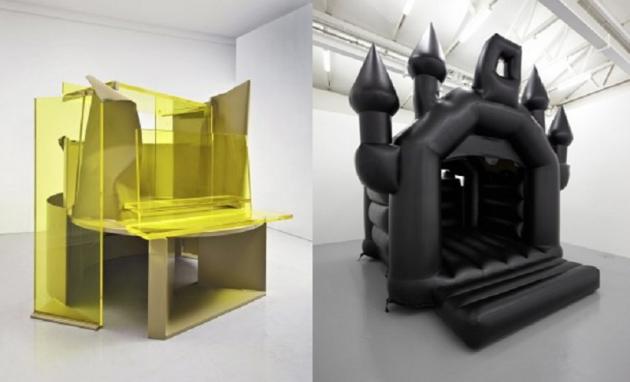This weekend Artlyst reviewer Olivia McEwan covers the most talked about exhibitions to see before the Frieze sets in!
This week sees a pleasing blend of the old and the new: selected entrants to the annual Illustration Awards are showing at Somerset House, while José Damasceno’s ‘Plot’ revitalises the Holborn library’s staid 1960s décor with an ArtAngel commissioned installation. Tom Dale makes child play of politics and power at the Copperfield gallery in SE1, while giants of the latter half of the 20th century Anthony Caro and Paula Rego are represented by Annely Juda and the Marlborough Gallery respectively.
Organised by the Association of Illustrators, the Illustration Award is the only annual jury selected competition of its kind in the UK, representing a panorama of the vast uses and professions for which illustration is currently employed. The most stimulating element of such a show is the density of themes and wholly contained projects displayed here: while contemporary fine art – and perhaps specifically painting – exists in relative isolation, meant to suggest, to ask more questions than answer, these graphic works are created to a brief, and as such exist as fully formulated responses.
Standouts include Laurindo Feliciano’s graphic work reflects the creative process within both fine art and fashion, likening it to that of a physician or anatomist working upon the blank canvas of the body, using medicine journal-like motifs. Breathtaking is Jillian Tomaki’s blending of precision graphics with painterly impression in an illustrated ‘Twenty Thousand Leagues Under the Sea’ created for the Folio Society: a reminder of how beautifully complementary visual accompaniments can so enhance the bare medium of text. Andy Ward’s series of posters commissioned by the University of California to raise mental health awareness are an ironic use of bright cartoon colours and fluffy animals to suggest that surface harmony may not be all as it seems: a devastating and hugely affecting sequence.
Worth visiting alone for a perfectly preserved slice of 1960s architecture and décor, the Holborn library is currently sporting a subtle and well integrated series of installations by José Damasceno, drawing on the idea of literary narrative linking the viewers’ experience through public spaces, bringing to attention the possibilities of scale. Thus in the main reading room, miniature silhouette figures derived from Letraset’s 1970s standardised characters created to inhabit architectural plans spring upside down from the ceiling; a direct literary evocation of Swift’s ‘Gulliver’s Travels’. Most interesting is his intervention on the top floor theatre – once used to screen back to back Hammer Horror films – imagining the theatre stage breaking into miniature islands floating throughout the audience space.
Annely Juda’s modestly sized galleries currently focus on the later works of Anthony Caro before his death in 2013, mainly his latter experimentation with Perspex. This is an exercise not in philosophical ideas pursued through visual medium, but in creating aesthetic sculptures that exist harmoniously independently and in plural. On paper looking like an afterthought, the careful matching of Perspex colour, opacity and shape actually adds an extra dimension to each piece, enhancing the endless interplay of facets and joins between plastic and rusted metal. Two of the works are in direct response to a visit to the Courtauld Gallery, more specifically Cézanne’s ‘Card players’, and make for an otherwise unlikely – though here proved brilliant – comparison between the two mediums. One can easily see how the faceted planes of pure coloured paint structured around hatched and angular linear outlines is translatable into the three dimensional models of interlocking and conflicting planes of Perspex or metal.
A giant of draughtsmanship, Paula Rego is another influential figure in British Art, here represented by Marlborough Fine Art, Mayfair. The usual dark themes and strong narrative are present – each piece a unified whole and crammed with visual detail and intrigue. Yet the work seems deliberately to be wandering into the realm of the currently fashionably naïve school: the strength of line has in some places been allowed to waver and falter, the grotesque element of bodily contortions and caricature allowed to come to the fore, rather than remaining a disturbing undercurrent. Adding to the equation is a greater conflict between medium, with the scratchiness of pencil line vying against swathes of patchily applied opaque white. Rego’s work has always been challenging in its dark nature, yet carried by the strength of line and strong composition: here we see works that threaten to become cluttered, uncomfortably disproportionate.
Crammed into the tiny Copperfield gallery tucked away in SE1 is Tom Dale’s ‘Department of the Interior’ – a giant bouncy castle made from bondage leather. While the current Turner Prize opens further down the river, filling Tate Britain with ideas barely made comprehensible (Duncan Campbell’s 54 minute long waffly video, anyone?), Dale’s point is powerful and concisely made. A slamming pun on the ‘child’s play’ that is the UK seat of power, or politics in general even, the castle entices and lures us in, despite its imposing, forbidding shiny black. Towering above us – yet forbidden to enter – it represents a false home, a chomping vagina, portcullis (portcuntis?) threatening to slam shut, with those inside engaging in the most childish, unashamed of practices. A well thought out idea, and well executed. Other pieces are slightly dwarfed, though no less intriguing. ‘I Cave’ is similarly a very simple idea: children’s party masks face inwards in a sphere, sprayed brilliant gold. Viewing through the mask eye-holes, we are posited in various guises and confronted with a distorted, glittering though obscured vision of ourselves in a curved mirror. Evoking Plato’s Allegory of the Cave, it questions what worlds we consider real or folly, a comment on superficiality and our own petty aspirations. A small but very consistent show.


